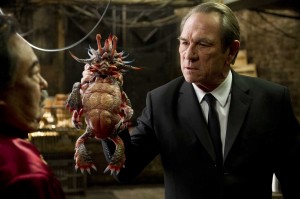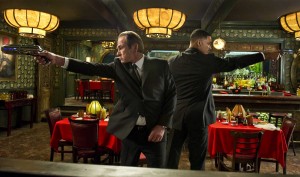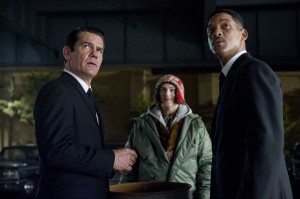
The film itself makes good use of the franchise’s emotional assets though, in creating a retroactive – and surprisingly affecting – “origin story” for Agents J and K (the former played by Will Smith, the latter essayed by both Tommy Lee Jones and Josh Brolin, due a time travel element critical to the story).
But 10 years is a century in “digital time,” and much has changed with how effects are rendered and wrangled – though in one nod to the effects themselves, aliens in a 1969 sequence are seen as contemporaneous, i.e. the way they might have appeared on a Star Trek installment, with make-up, prosthetics, and Rudy Gernreich-y costumes).
Sharing supervisorial duties with the storied Ralston was Jay Redd, who said that despite the time between installments, his “goal was to maintain the Men in Black look and feel,” but acknowledged that even “lighting tricks have changed a lot” since the last film hit theaters.
To get the film done – after a “fast and furious” shoot in New York – required a diversity of work in post.

But because of the film’s time travel elements, there were not only characters, but digital environments to tend to, including taking the Chrysler Building back to its late-’60s look, Cape Canaveral during the first moon launch, and Shea Stadium during that same storied summer when the Mets began their march toward the World Series.
For the latter, there was a small set for close-ups along with set extensions, but as they started editing, aesthetic choices won over historical accuracy, with the upper level needing to be cantilevered differently to make certain shots work, and in others, proportions changed from 1:1 with digital modeling to 3:1, all to look more plausible on the screen.
Since Columbia knew from the beginning they wanted the movie in 3-D, Hahn was in on early tests with film and digital cameras, and post-filming conversions with Will Smith. They eventually opted to convert in post, to provide more freedom for camera setups.
Among things extruding from the screen were the aforementioned alien creatures, and those were overseen by animation supervisor Spencer Cook. “This was the first comedy I’d done,” he says, where the critters themselves “had to be funny.”
His pedigree includes various Spiderman and Matrix installments, but it also stretches back to TV and Pee-Wee’s Playhouse, and yet, despite the admonition to be funny, director Barry Sonnenfeld (returning for the third-time) said, “don’t overdue it. You have to be able to play comedy very seriously.”
One example he cites is when a slew of small alien “worm guys” are playing bagpipes during a somber occasion in the film – the tune is “Amazing Grace.” But the off-world pipers were “doing too much of a schtick,” according to the director. The joke, he underscored, is simply that “the worm guys are playing bagpipes. And now it feels more realistic. The worm guys are taking their job seriously.”

Another scene involved the stark consequences of violating the old precept of not looking in the restaurant kitchen if you want to enjoy your meal. The restaurant in question is in New York’s Chinatown, and when agents J & K peek in, a slew of alien creatures – most of them aquatic (and many of them menu items) – greet them. And in some cases fight them.
One such outsize opponent used both walrus and sea elephant references, because they needed “to make the audience believe this is a real, breathing thinking animal. We looked at these larger creatures to see what makes them feel heavy,” but it came with an ability to jump that added the fantasy elements.
Smith had to have his encounter with the beast before it was rendered, so as the scene originally played out in front of a greenscreen, Cook remembers, with Smith, you could see the other “reality” elements “in his face – all this effort, all this strain. He’s really selling this.”
Indeed, we might say that Smith is selling his encounter with a CGI creature, except that Cook takes exception to that acronym. “I’m on a crusade,” he says, “to eliminate CGI from our industry. A computer doesn’t deserve any more credit than a paint brush.”
Though as paint brushes go, Hahn noted that Imageworks had “a fairly robust and established pipeline” to work in-house and with other houses, deploying, among other things, Maya, for much rendering, along with the Imageworks-created KATANA for lighting effects, Endorphin for the “human characters crashing about,” and a new iteration of Houdini for “fluid solvers.”
As for the acronym question, Redd says that terms like “computer-generated” conjure up images of engineers rather than artists. He wants to steer the credit more to the human side, adding that good effects are about “everybody getting in there and having fun with the material,” to which Ralston adds, “you’ve got to know what not to tweak.”
Speaking of the re-shoots and brief shutdowns that became the subject of much lively and speculative reporting during production, Ralston says “we’ve been able to take some not ideal situations, and turn them into something pretty cool.”
And simultaneously, something both familiar and – after MIB’s 10-year absence from screens – new, all at once. Like say, a jumping walrus-like creature leaping from a fish tank at the eatery just down the street.





